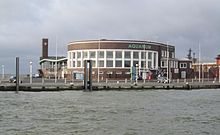Aquarium Wilhelmshaven
The Wilhelmshaven Aquarium is a show aquarium and museum in the Lower Saxony town of Wilhelmshaven on the Jade Bay on the south beach promenade. In over 600,000 liters of salt and fresh water, it shows more than 300 animal species from the earth's oceans. In May 2015 the aquarium was expanded to include a prehistoric museum, which shows the development of life using 500 aquatic fossils. The Aquarium Wilhelmshaven Bullermeck GmbH operates the aquarium without public aid.
In the beach hall there is also a panorama restaurant and the Bullermeck children's play palace .
exhibition
Primeval Sea Museum
In the only primeval sea museum in northwest Germany, visitors take a journey through time through all the geological ages of the planet. Using more than 500 original aquatic fossils, you will learn how various animal and plant species have come into being through evolution over the past 4.6 billion years. The highlight is the over 3 m large fossil of a great white shark from the Palatinate.
Aquarium
The tour through the aquarium leads through the world of the oceans and habitats of our earth starting with the unique flora and fauna from the North Sea and the Wadden Sea : flatfish , cat sharks , lobsters and edible crabs live in naturally furnished aquariums. The highlight is the North Sea water basin of the seals Paul, Piet and Ole. In three aquariums explored octopus with its eight arms its surroundings, seahorses weigh between seaweed and jellyfish centrifugal seem jellyfish float.
Blacktip reef sharks , zebra sharks and cow-nosed rays live in the large Atlantic community basin in the tropical sea . Swarms of silver fin leaves , sweetlips , pig grunts and many other fish species can also be seen here.
In the Antarctic area - for the first time in the world - fish species will be presented that have developed antifreeze in their blood and live under the ice of the Antarctic at a water temperature of 0 ° C. The Magellanic penguins show their "flying skills" under the water surface.
Different inhabitants live in the dense rainforest, including free-flying birds, pygmy marmosets and a chameleon . A caiman lurks in the water and colorful sea creatures cavort between coral reefs.
history
The Wilhelmshaven Aquarium can look back on an eventful history spanning more than 90 years. On April 11, 1927, the inauguration took place in the beach hall. After a war-related interruption from 1939 to 1945, the aquarium was reopened on August 17, 1950 at its current location under the direction of Konrad Lüders. The city of Wilhelmshaven was the operator with scientific advice from the Senckenberg-am-Meer research institute. In 1988/89 the sea water aquarium was expanded to include a seal hall. The structure of the aquarium was so badly attacked by salt and the weather that it had to be closed in 2001. Due to a lack of funds, the city sold the entire facility, including the beach hall, to the Wilhelmshaven Bullermeck GmbH Aquarium . For this purpose, the seawater aquarium was largely demolished, gutted, rebuilt and given an additional floor. The Wilhelmshaven Aquarium has been operated without public subsidies since it reopened on July 7, 2002. In 2015, the Primeval Sea Museum was opened with the exhibition of a fossil collection of aquatic origin, with a unique selling point in the entire northwest.
The beach hall now houses a panorama restaurant and the Bullermeck children's play palace , both of which can be visited independently of the aquarium.
literature
- AQUARIUM WILHELMSHAVEN BULLERMECK GmbH: Aquarium guide , 2016.
Web links
- Official website
- Wilhelmshaven - sights from A to Z
- Headwind No. 181: Seawater aquarium reopened after renovation
Coordinates: 53 ° 30 '48.2 " N , 8 ° 8' 39.8" E


